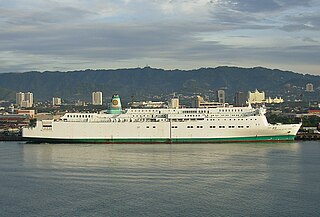
German submarine U-20 was a Type IIB U-boat of Nazi Germany's Kriegsmarine. Her keel was laid down on 1 August 1935, by Germaniawerft of Kiel as yard number 550. She was commissioned on 1 February 1936. During World War II, she conducted operations against enemy shipping.

Sevmorput is a Russian nuclear-powered cargo ship. The 1988-built vessel is one of only four nuclear-powered merchant ships ever built and, after returning to service in 2016 following an extensive refit, the only such vessel to remain in service as of 2023.

The MS al-Salam Boccaccio 98 was an Egyptian Ro/Ro passenger ferry, operated by El Salam Maritime Transport, that sank on 3 February 2006 in the Red Sea en route from Duba, Saudi Arabia, to Safaga in southern Egypt.

MS Arctic Explorer was a ship which sank off St. Anthony, Newfoundland, in the Strait of Belle Isle, on 3 July 1981.

Loch Vennachar was an iron-hulled, three-masted clipper ship that was built in Scotland in 1875 and lost with all hands off the coast of South Australia in 1905. She spent her entire career with the Glasgow Shipping Company, trading between Britain and Australia. The company was familiarly called the "Loch Line", as all of its ships were named after Scottish lochs. The ship was named after Loch Venachar, in what was then Perthshire.

MV Princess of the Stars was a passenger ferry owned by Filipino shipping company Sulpicio Lines, that capsized and sank on June 21, 2008, off the coast of San Fernando, Romblon, at the height of Typhoon Fengshen, which passed directly over Romblon as a Category 2 storm. 814 people died.
CCGS Earl Grey is a Samuel Risley-class light icebreaker and buoy tender in the Canadian Coast Guard. Constructed in 1986, the vessel serves a variety of roles, including light ice-breaking and buoy tending, as well as being strengthened for navigation in ice to perform tasking along the shores off the Atlantic coast of Canada. Like her sister ship, CCGS Samuel Risley, she carries a large and powerful crane on her long low afterdeck for manipulating buoys. Earl Grey is the second icebreaker in Canadian service to carry the name.

MV Baltic Ace was a Bahamian-flagged car carrier, that sank in the North Sea on 5 December 2012 after a collision with the Cyprus-registered container ship Corvus J. Built by Stocznia Gdynia in Poland, the ship had been in service since 2007.

MOL Comfort was a 2008-built Bahamian-flagged post-Panamax container ship chartered by Mitsui O.S.K. Lines. The vessel was launched in 2008 as APL Russia and sailed under that name until 2012, when the ship was renamed to MOL Comfort. On 17 June 2013, she broke in two about 200 nautical miles off the coast of Yemen. The aft section sank on 27 June and the bow section, after having been destroyed by fire, on 11 July.
MV Stellar Daisy was a South Korean-owned very large ore carrier (VLOC) that sank on March 31, 2017 in the South Atlantic off the coast of Uruguay while on a voyage from Brazil to China. She was the largest ship, by a factor of nearly 2 on gross tonnage, to be lost at sea.
The Sanchioil tanker collision occurred on 6 January 2018 when the Panamanian-flagged, Iranian-owned tanker Sanchi, with a full natural-gas condensate cargo of 136,000 tonnes, sailing from Iran to South Korea, collided with the Hong Kong-flagged cargo ship CF Crystal 160 nautical miles (300 km) off Shanghai, China. Sanchi caught fire shortly after the collision; after burning and drifting for over a week, it sank on 14 January.

Maersk Honam is a container ship operated by Maersk Line. The vessel caught fire on 6 March 2018 while sailing in the Arabian Sea. Five members of the crew of 27 were killed, including one rescued crew member who died later from injuries.
MV Volgo-Balt 214 was a Panama-flagged Ukrainian general cargo ship, which sank in the Black Sea off the coast of Samsun, Turkey on 7 January 2019. Six of the thirteen crew members on board died while seven of them were rescued by the Turkish authorities and taken to hospital.

Gulf Livestock 1 was a Panamanian-registered livestock carrier which sank 100 nautical miles (185 km) west of Amami Ōshima Island in southwest Japan on 2 September 2020 due to Typhoon Maysak.
MV Salvador Allende was a cargo ship that sank in December 1994 in the North Atlantic Ocean with the loss of 29 of her 31 crew members.

MV Waimarama was a UK refrigerated cargo liner. She was built in Northern Ireland for Shaw, Savill & Albion Line and launched in 1938. She carried perishable foods, particularly meat, from New Zealand to the United Kingdom.
SS Santa Fé was a German refrigerated cargo steamship. She is now a Black Sea shipwreck and part of her cargo is of interest to marine archaeologists.











